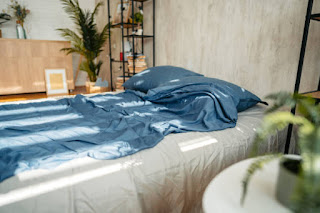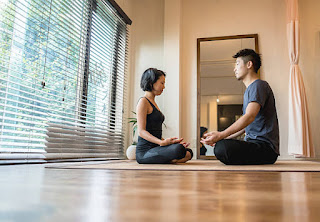Creating a Sleep Sanctuary: Yoga, Meditation, and Mindful Space Design
Creating a Sleep Sanctuary: Yoga, Meditation, and Mindful Space Design
In our fast-paced world, quality sleep is becoming increasingly elusive. Many of us focus on the physical aspects of rest—whether it’s practicing yoga or meditating—but we often overlook the importance of creating a serene environment that supports and nurtures a restful night. Integrating the philosophies of yoga and meditation into your bedroom space can profoundly impact the quality of your sleep. This article goes beyond physical practice, delving into the art of mindful space design to create a sleep sanctuary that truly supports rest and rejuvenation.
By incorporating elements such as calming colors, dim lighting, aromatherapy, and clutter-free spaces, we can create a room that not only looks peaceful but also feels that way. Whether you share a room, struggle with distractions like clutter, or have trouble winding down, this guide will provide a slow and steady approach to transforming your bedroom into a peaceful haven for restful sleep.
The Connection Between Space and Sleep
Before diving into the specifics, it’s important to understand the underlying connection between our environment and our sleep quality. The ancient philosophy of Vastu Shastra, often called the “yoga of space,” teaches us that the energy of our environment directly influences our mental state and, therefore, our ability to rest. Similarly, Feng Shui, a Chinese philosophy, emphasizes that how we arrange and design our space can promote positive energy flow (qi) and ultimately lead to better health and sleep.
From these philosophies, we learn that an ideal sleep environment is one that allows energy to flow freely, promoting relaxation and peace. An ideal sleep space should feel balanced, restorative, and quiet—providing the body and mind with a nurturing space to recharge.
The Look, Feel, and Smell of a Serene Sleep Space
What does a sleep sanctuary look like, feel like, and smell like? The key lies in designing an environment that appeals to all of your senses, encouraging your body to unwind and your mind to relax.
Calming Colors
Colors influence our mood and energy levels more than we may realize. In line with yogic and meditative philosophies, it’s crucial to choose soft, muted tones for your bedroom. Shades of light blue, soft green, and pastel lavender promote calmness and relaxation. These colors help lower stress levels and evoke a feeling of serenity, aiding in the process of winding down before sleep.
Practical Tip: If painting your walls isn’t feasible, start small by incorporating these colors through bedding, throw pillows, or curtains. This can ease the transition to a more calming environment without drastic changes.
Dim Lighting
Lighting plays a pivotal role in signaling to the brain that it’s time to wind down. Bright lights, especially artificial ones from devices, can overstimulate the brain and make it harder to fall asleep. Soft, dim lighting, such as warm-toned lamps, candles, or Himalayan salt lamps, creates a more soothing atmosphere conducive to sleep. This is also supported by Ayurvedic practices, which teach that overstimulation from bright lights before bed can aggravate the nervous system, leading to disrupted sleep patterns.
Practical Tip: Consider installing dimmer switches or using low-wattage bulbs in the evening. Set a “lighting routine” by dimming the lights an hour before bedtime to help signal to your body that it’s time to rest.
Aromatherapy for Sleep
Scents are closely tied to the limbic system, the part of the brain that controls emotions and memory. Certain scents, like lavender, chamomile, and sandalwood, have been scientifically proven to reduce anxiety and promote relaxation, making them ideal for a sleep-friendly environment. Aromatherapy, a practice grounded in Ayurvedic medicine, uses these scents to align the body’s energy with the natural rhythms of the environment.
Practical Tip: Incorporate essential oils into your nightly routine by using a diffuser or lightly spritzing your pillow with lavender oil. If you prefer, place a sachet of dried lavender near your bedside or hang it by your bed to infuse the air with its calming scent.
Decluttering for a Clear Mind and Restful Sleep
A cluttered space often leads to a cluttered mind. According to yogic philosophy, physical clutter can block the free flow of prana, or life energy, which can affect our mental clarity and stress levels. To improve your sleep quality, decluttering your bedroom is essential. A clean, organized space makes it easier for your brain to unwind and for your body to rest peacefully.
How to Declutter Without Overwhelm
- Start Small: Focus on one area of the room at a time. Begin with your nightstand, then gradually move to your dresser, floor, and closet. You don’t have to do it all in one day.
- Remove Distractions: Keep electronic devices out of the bedroom as much as possible. TV screens, phones, and tablets emit blue light, which disrupts melatonin production and interferes with your natural sleep cycle.
- Incorporate Minimalism: Follow the principles of aparigraha (non-attachment) from yoga. Keep only what serves your sleep and relaxation, and release items that create unnecessary mental or physical noise.
In my article, “Yoga at Home: Creating a Personal Sanctuary for Mind, Body, and Soul,” I explored how decluttering is not just about the physical act of cleaning but also about clearing the mental space for self-care. This process should be approached with patience and self-kindness—your sleep space is your sanctuary, and creating it should feel empowering, not overwhelming.
The Importance of Mindful Space Design
When designing a space for sleep, it’s essential to consider how the room itself influences your energy. Feng Shui suggests that the placement of your bed can affect your energy flow. Positioning your bed against a solid wall and facing the door (without being directly in line with it) gives a feeling of security and allows energy to flow harmoniously throughout the room.
Additionally, elements like natural materials (wood, cotton, wool) promote grounding, while keeping windows open during the day allows fresh air and natural light to cleanse and refresh the space. In contrast, heavy, stagnant air and synthetic materials may contribute to feelings of restlessness or discomfort.
Practical Tip: Bring nature indoors by incorporating live plants, natural textiles, and wooden furniture into your room. Not only do these elements ground your energy, but they also improve air quality, helping you sleep more deeply.
Patience and Kindness: A Gradual Transition to a Restful Space
Creating a sleep sanctuary isn’t a one-night task. It’s a process that involves both inner and outer transformation. Yoga and meditation philosophies teach us that change should be approached slowly, with self-compassion. Just as we progress gradually in our physical practice, we can make small adjustments in our sleep space that accumulate into a serene environment over time.
How to Begin the Transformation
Set an Intention: Decide which aspect of your room you want to start with. Perhaps you’ll begin by decluttering your nightstand or switching to dim lighting in the evenings.
Focus on One Change at a Time: Rather than trying to revamp your entire space at once, implement one small change each week. This will help you avoid burnout and allow you to savor each improvement.
Mindfully Reflect: After making a change, observe how it affects your sleep and energy. Do you feel more relaxed? Is your mind quieter at night? Journaling about these shifts can help you stay mindful of the process and appreciate the improvements as they unfold.
Sharing a Space: Balancing Multiple Needs in a Sleep Sanctuary
For those who share a sleeping space, creating a peaceful environment can be more challenging. However, mindful design can help balance different needs. For instance, while one person might prefer dim lighting, another might need a small nightlight. The key is to communicate openly and work together to create a space that accommodates both partners’ needs.
Practical Tip: Use room dividers, curtains, or separate lighting to create individualized zones within the shared space. You can also employ noise-cancelling devices or white noise machines to reduce disturbances, ensuring that both partners enjoy a restful sleep.
Incorporating Mindful Practices Without Overwhelm
One of the biggest challenges in creating a sleep sanctuary is the potential for burnout. For those already feeling overwhelmed by clutter, chaos, or a busy schedule, the idea of revamping an entire room can feel daunting. It’s important to approach this process gently and with patience.
Rather than attempting to make all changes at once, begin with one simple practice. Perhaps you start by listening to the Powered by Joy Podcast episode on sleep, incorporating a guided meditation into your nightly routine. As you establish new habits, like dimming the lights earlier in the evening or using aromatherapy, these small steps will begin to compound into a much more serene and supportive sleep space.
Building Your Own Sleep Sanctuary
Creating a mindful sleep environment is about more than just changing the aesthetics of your bedroom. It’s about fostering a space that aligns with the principles of yoga and meditation, nurturing both body and mind. With a focus on calming colors, dim lighting, natural elements, and decluttering, you can create a sanctuary that supports deeper, more restorative sleep.
By making small, mindful changes—whether it’s introducing aromatherapy, clearing clutter, or shifting your bedroom layout—you can slowly transition from a disruptive sleep environment to a serene, restful space. And remember, just as in your yoga and meditation practice, this transformation takes time and self-kindness.










